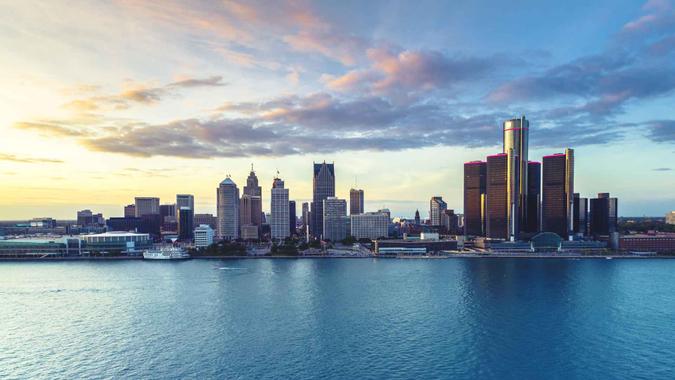
The cost of living in most of America’s most populous cities is rather high and can seriously eat into your monthly budget — especially if you’re living off nothing but Social Security income. That begs the question: Just how far could you last on nothing but Social Security in America’s major cities?
Check Out: How Far $1.5 Million in Retirement Savings Plus Social Security Goes in Every State
Also See: 6 Safe Accounts Proven To Grow Your Money Up To 13x Faster
GOBankingRates recently sought to answer that. Analyzing the cost of living in America’s 50 biggest cities (based on population) and the average Social Security income, GOBankingRates was able to calculate just how far Social Security income payments could last a person monthly in each major American metropolis. GOBankingRates then organized the cities by region (West, South, Northeast and Midwest) and ordered them from those where Social Security lasts the longest to the shortest amount of time.
In the Midwest, Detroit is the only city where you might be able to get by solely on Social Security. See how much more you would need to pay the bills in other Midwest cities.

1. Detroit
- % of population 65+: 16.1%
- How much is left over after Social Security: $485
- Monthly cost of living: $2,478
- Monthly expenditures (minus housing): $2,050
In Michigan’s largest city, Detroit, your monthly cost of living would be more than covered by the average Social Security income. Specifically, a Social Security check can cover 119.6% of your monthly bills in the Motor City. That is the most among all cities in the U.S. study.
Learn More: 8 States To Move to If You Don’t Want To Pay Taxes on Social Security
Discover More: 5 Cities You Need To Consider If You’re Retiring in 2025

2. Milwaukee
- % of population 65+: 12.8%
- How much more a couple needs after Social Security: $154
- Monthly cost of living: $3,117
- Monthly expenditures (minus housing): $1,884
Cost of living in Milwaukee is such that Social Security income can cover 95% of the monthly bills there.
Explore More: Need To Cut Expenses While on Social Security? Here’s the First Thing To Get Rid Of

3. Indianapolis
- % of population 65+: 13.6%
- How much more a couple needs after Social Security: $174
- Monthly cost of living: $3,137
- Monthly expenditures (minus housing): $1,835
The average monthly Social Security income can last 28.7 days for Indy recipients. If you make a tad more than the average, your benefits should cover everything.

4. Kansas City, Missouri
- % of population 65+: 14.4%
- How much more a couple needs after Social Security: $311
- Monthly cost of living: $3,275
- Monthly expenditures (minus housing): $1,884
Social Security income can go rather far in Kansas City, paying 90.5% of the monthly cost of living in the city.

5. Columbus, Ohio
- % of population 65+: 11.8%
- How much more a couple needs after Social Security: $349
- Monthly cost of living: $3,312
- Monthly expenditures (minus housing): $1,828
Residents of Columbus who receive Social Security can make it 27 days without any other form of income, as the benefits will cover 89.5% of the city’s cost of living.
Be Aware: Social Security Benefits Might Be Harder To Qualify for in the Future — Here’s What You Need To Know

6. Omaha, Nebraska
- % of population 65+: 15.5%
- How much more a couple needs after Social Security: $614
- Monthly cost of living: $3,577
- Monthly expenditures (minus housing): $1,961
You can last 25.2 days per month on nothing but Social Security income in Omaha.

7. Chicago
- % of population 65+: 14.2%
- How much more a couple needs after Social Security: $772
- Monthly cost of living: $3,735
- Monthly expenditures (minus housing): $2,000
The Windy City isn’t exactly cheap, meaning that Social Security income can cover just 79.3% of the monthly cost of living there.

8. Minneapolis
- % of population 65+: 12.1%
- How much more a couple needs after Social Security: $829
- Monthly cost of living: $3,792
- Monthly expenditures (minus housing): $1,844
As a resident of Minneapolis, you can last 23.8 days per month on nothing but Social Security income, which pays for 78.1% of the monthly cost of living there.
Methodology: Population data was sourced from the U.S. Census American Community Survey. Cost of living was determined using data from Sperling’s BestPlaces, the Bureau of Labor Statistics Consumer Expenditure Survey, Zillow Home Value Index and Federal Reserve Economic data. The average Social Security income was sourced from the Social Security Administration for August 2025 and used to calculate the daily income from Social Security income. All data was collected on Sept. 26, 2025.
More From GOBankingRates
This article originally appeared on GOBankingRates.com: How Long You Could Last on Nothing but Social Security in 8 Major Midwest Cities







